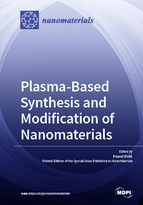Plasma based Synthesis and Modification of Nanomaterials
A special issue of Nanomaterials (ISSN 2079-4991).
Deadline for manuscript submissions: closed (25 August 2018) | Viewed by 45214
Special Issue Editor
Interests: trace element analysis using spectrometric methods (ICP OES, ICP MS, FAAS, and ETAAS); speciation and fractionation analysis of metals and metalloids using chromatographic separation; application of chemical vapor generation (CVG) techniques for analytical atomic and mass spectrometry; analytical and spectroscopic characteristics of cold atmospheric pressure plasmas (CAPPs); application of CAPPs in biology, medicine, and technology
Special Issues, Collections and Topics in MDPI journals
Special Issue Information
Dear Colleagues,
Interaction of atmospheric pressure plasmas (APPs), driven by direct, alternating or radio frequency current, with liquids has gained a lot of interest in recent years because of the possibility of simple and versatile synthesis of different nanoparticles and nanocrystals, modification of their surfaces, or production of composite nanomaterials and alloys. Indeed, by contrast to conventional liquid phase synthesis methods, APPs operated in or in contact with liquids containing appropriate precursors and stabilizers are viable to produce nanoparticles and other nanoscale materials at ambient conditions in a fast, usually one-stage and scalable way. Minimizing the number of manipulations involved in the synthesis process and enhancing possibility of functionalization and size modification, methodology based on APP operated in different configurations and gases allows to fabricate safe and biocompatible nanomaterials that could be applied in many areas of biology, medicine and technology.In this context, the current Special Issue is dedicated to scientists and researchers dealing with fabrication of new nanoparticles and nanomaterials by APP-based methods and application of these materials in different areas of science and technology. Original research and review articles that seek to new developments in plasma synthesis of nanomaterials are highly welcome. Potential topics include, but are not limited to:·
- plasma-mediated synthesis of nanoparticles and nanocrystals in liquid and gas phases along with characterization of structure and morphology of these nanomaterials
- fabrication of nanoparticles of tunable size and optical properties by controlling experimental conditions of APP-based systems
- application of APPs for modification of functionality and properties of nanomaterials
- application of nanometerials fabricated with the aid of plasma-based synthesis methods in biology, medicine and technology.
Prof. Dr. Pawel Pohl
Guest Editor
Manuscript Submission Information
Manuscripts should be submitted online at www.mdpi.com by registering and logging in to this website. Once you are registered, click here to go to the submission form. Manuscripts can be submitted until the deadline. All submissions that pass pre-check are peer-reviewed. Accepted papers will be published continuously in the journal (as soon as accepted) and will be listed together on the special issue website. Research articles, review articles as well as short communications are invited. For planned papers, a title and short abstract (about 100 words) can be sent to the Editorial Office for announcement on this website.
Submitted manuscripts should not have been published previously, nor be under consideration for publication elsewhere (except conference proceedings papers). All manuscripts are thoroughly refereed through a single-blind peer-review process. A guide for authors and other relevant information for submission of manuscripts is available on the Instructions for Authors page. Nanomaterials is an international peer-reviewed open access semimonthly journal published by MDPI.
Please visit the Instructions for Authors page before submitting a manuscript. The Article Processing Charge (APC) for publication in this open access journal is 2900 CHF (Swiss Francs). Submitted papers should be well formatted and use good English. Authors may use MDPI's English editing service prior to publication or during author revisions.
Keywords
- atmospheric pressure plasma
- plasma-liquid interactions
- plasma synthesis
- nanoparticles
- nanomaterials
- functionalization
- modification
- biology
- environmental engineering
- medicine







